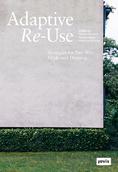identity Community waterfronts & harbors infrastructures collaborative urban design renaissance commerce local plans premio letteratura urbanistica paesaggio land use ricerca public policies ecology welfare knowledge competition urban renewal inclusive processes news economics representation neighborhood call for articles scenarios
Adaptive Re-Use
Strategies for Post-War
Modernist Housing
Maren Harnack, Natalie Heger and Matthias Brunner (eds.)
In prosperous regions, housing markets are under significant pressure. With the focus on preserving land and developing brownfield sites, post-war housing estates are being earmarked for densification, as their density is perceived as rather low and the ownership is often concentrated in the hands of only a few publicly owned housing associations. In this setting, post-war estates are in danger of losing their characteristic spatial structures and landscaping.
Adaptive Re-Use discusses strategies for the development of post-war housing by referring to European case studies from the period of 1945 to 1975. The contributions in this edited volume show how housing estates from different European countries are listed and preserved, and how architectural fabric can be adapted to meet today’s needs.
Environmental concerns and resource awareness are increasingly gaining weight in the professional conservation discourse. And yet contemporary buildings also continue to gain heritage status on the basis of conventional considerations. Thus, the general public's appetite for preserving buildings from the 1960s to 1980s is growing, whether for remembrance, historical reassurance, orientation, pride, or a sense of home.
(Extract from the chapter "Large-scale Heritage. A Conservation Perspective on Late Modernist Housing" by Mark Escherich)
ABOUT THE AUTHORS
Mark Escherich completed an apprenticeship as a carpenter. He has studied civil engineering, architecture and art history | Teresa Cunha Ferreira holds a degree from the Faculty of Architecture at the University of Porto (FAUP) and European PhD at the Polytechnic of Milan (2009) | Nicole Froberg studied architecture at the TU Braunschweig. As a freelancer, she collaborated with the City of Waitsburg on several projects | Miles Glendinning is Director of the Scottish Centre for Conservation Studies and Professor of Architectural Conservation at the University of Edinburgh | Martin Hahn studied geography, art history, and preservation of monuments in Marburg and Bamberg. He earned his Ph.D. at the Technical University of Berlin | Maren Harnack is an architect, urban planner and professor for urban design at Frankfurt University of Applied Sciences | Natalie Heger is an architect and postdoc at the Post-War Modernist Housing Research Lab at Frankfurt University of Applied Sciences | John Klepel is an architect and researches building typologies at TU Berlin (with Professor Finn Geipel).
Online resources and links




Planum
The Journal of Urbanism
ISSN 1723-0993
owned by
Istituto Nazionale di Urbanistica
published by
Planum Association
ISSN 1723-0993 | Registered at Court of Rome 4/12/2001, num. 514/2001
Web site realized by ChannelWeb & Planum Association | Powered by BEdita 3

